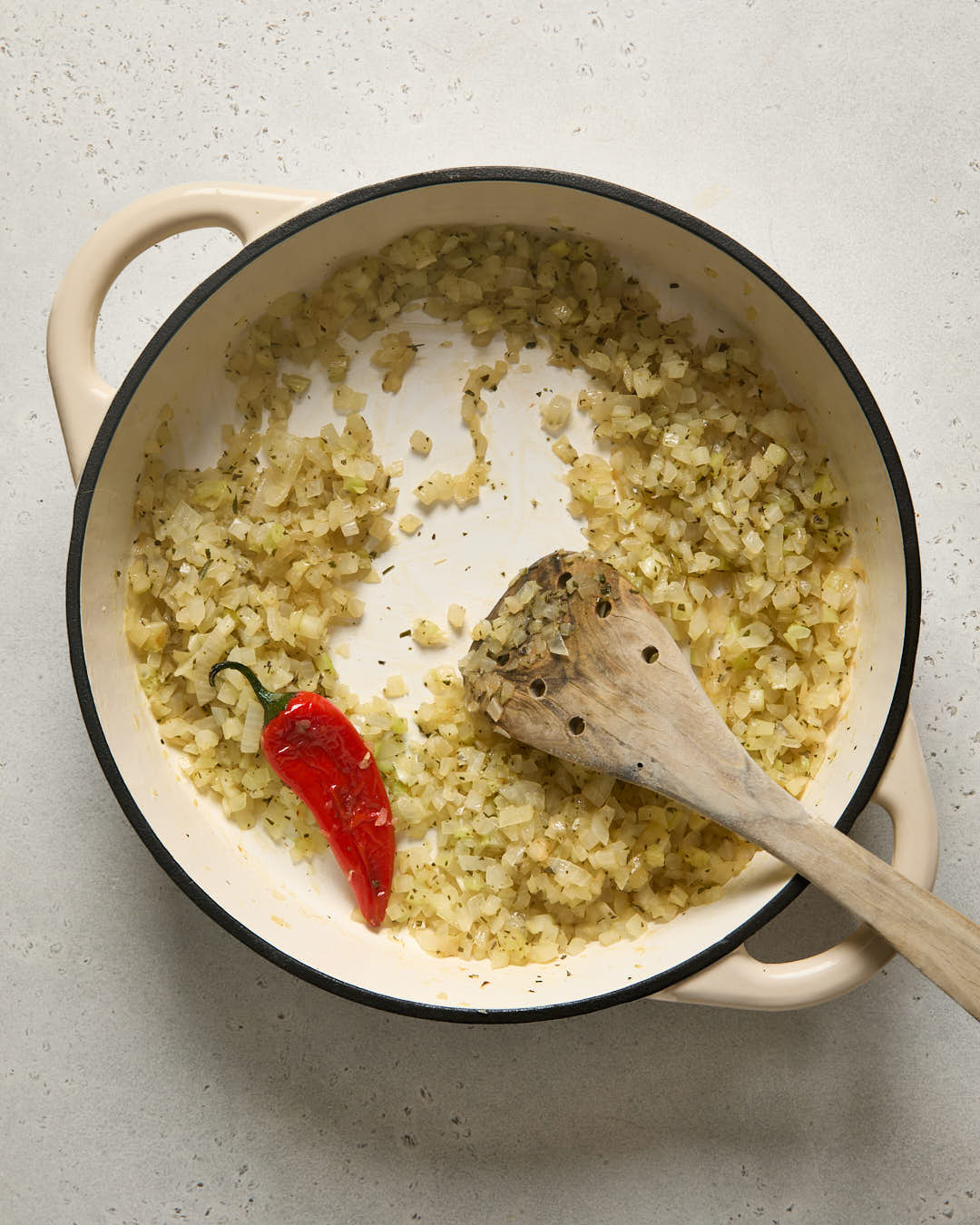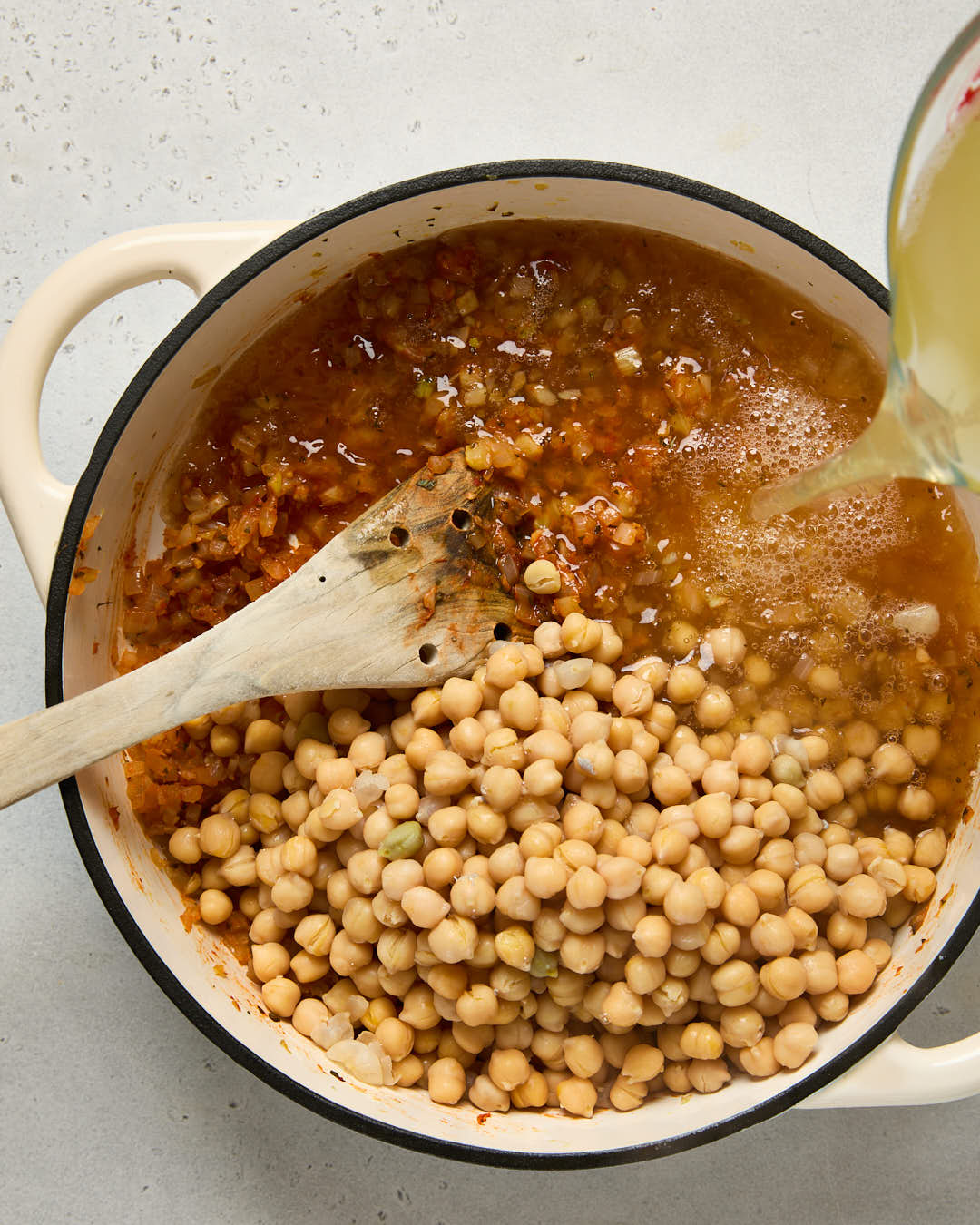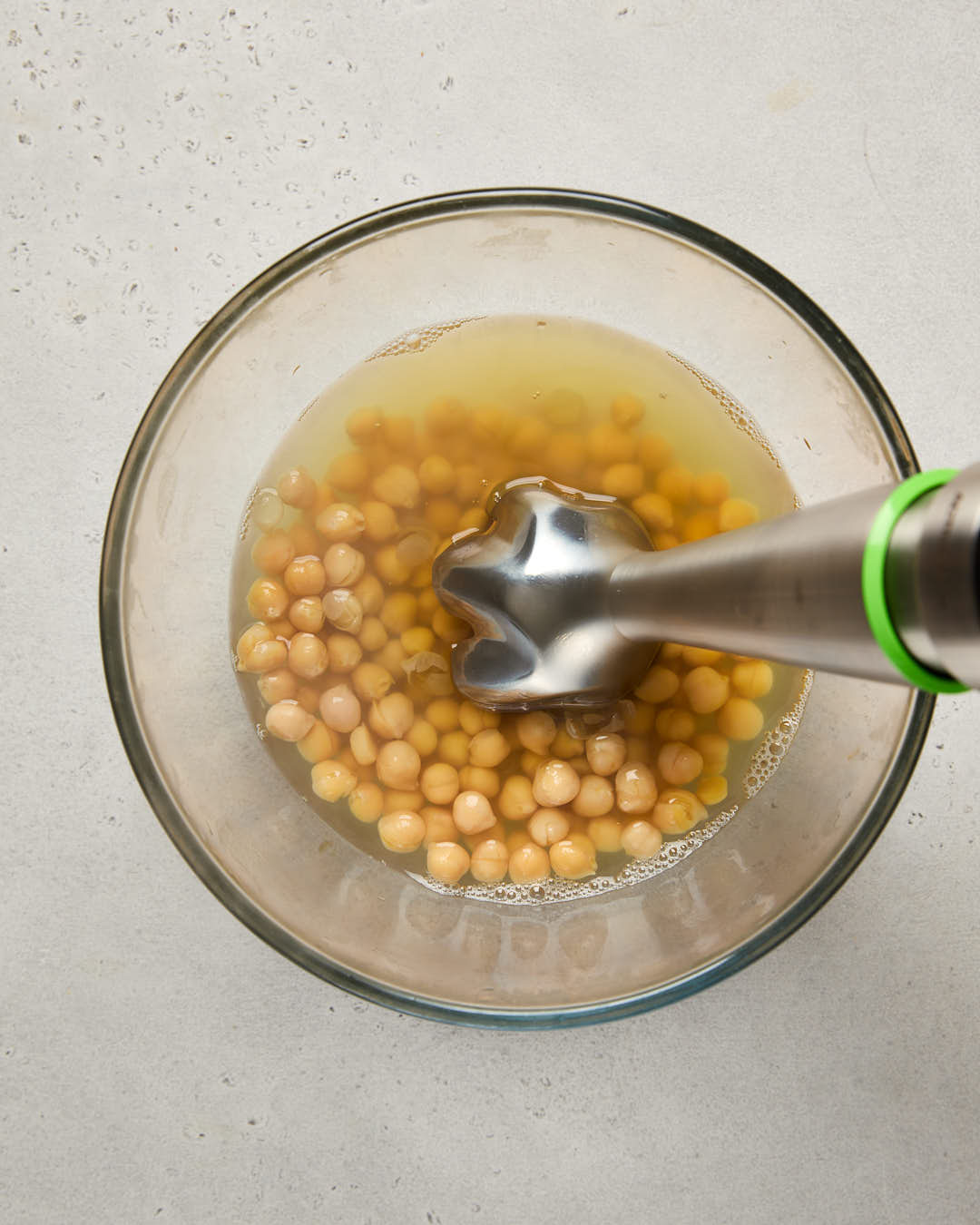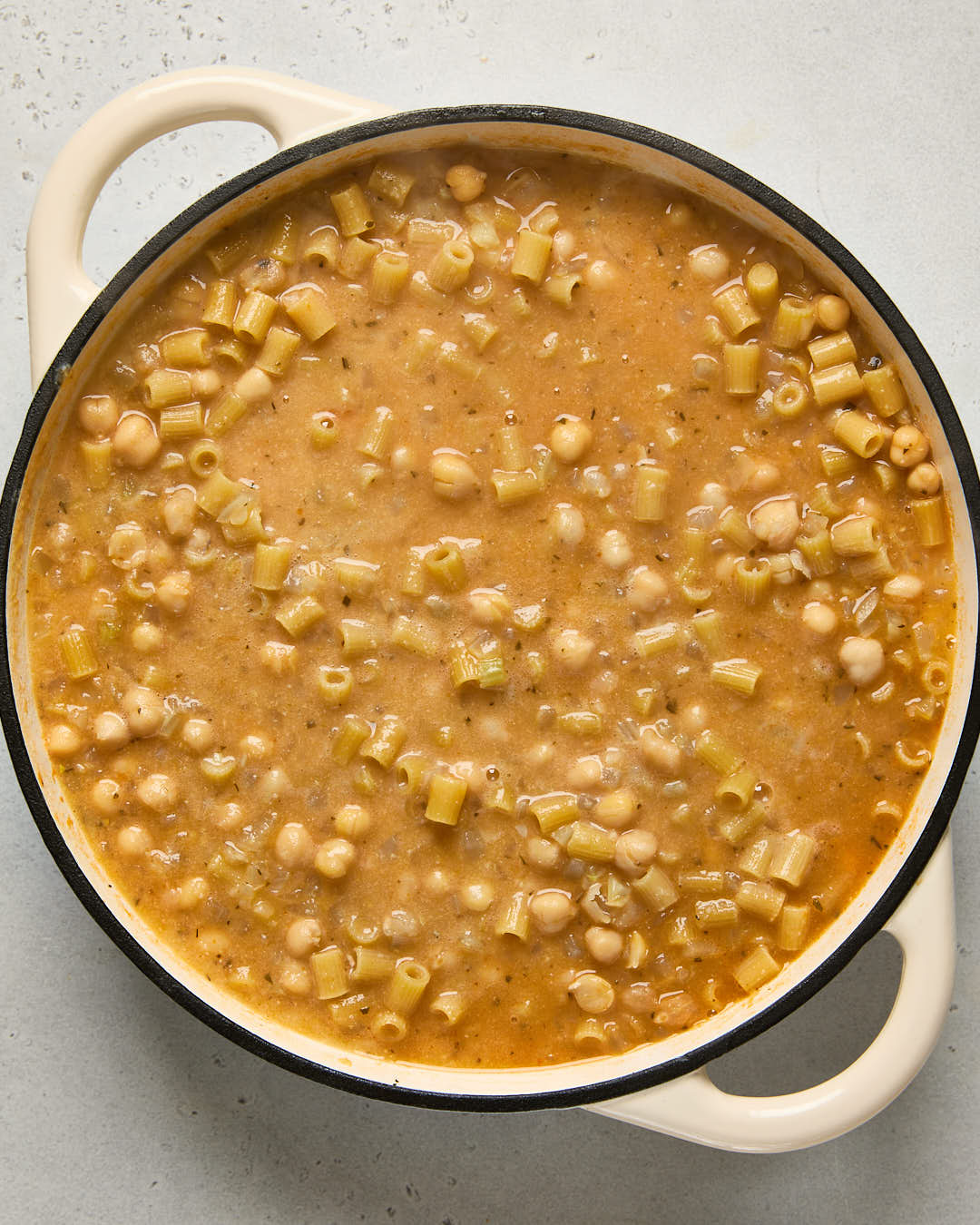Pasta e Ceci (Italian Pasta and Chickpea Stew)

What is Pasta e Ceci?
Pasta e Ceci is a traditional Italian dish that epitomizes the cucina povera philosophy—the art of transforming simple, common ingredients into something far greater than the sum of its parts. This ancient Italian massa (thick soup) combines tender chickpeas and small pasta shapes in a savory, aromatic broth, creating a comforting and satisfying meal that happens to be traditionally vegan.
This recipe showcases the thoughtful preparation that defines cucina povera. A hearty soffritto of garlic, onion, celery, and rosemary forms the flavorful base, while a ladleful of cooked chickpeas is blended and stirred back into the dish to thicken the broth slightly. The result is a perfectly balanced texture—creamy yet hearty, and full of rustic charm.
Regional variations of Pasta e Ceci can be found across Italy, particularly in the south, from Lazio to Calabria. This version draws inspiration from the cooking of Campania, where the dish is kept simple and wholesome. In Puglia, a similar dish called Ciceri e Tria features pasta fried separately and scattered over the broth for added crunch.
Whether enjoyed as a thick stew or a lighter soup, Pasta e Ceci is a timeless comfort food. Its combination of small pasta shapes, tender chickpeas, and aromatic herbs makes it both an easy weeknight dinner idea and an exploration of authentic Italian cooking.

The History of Pasta e Ceci
Pasta e Ceci, or pasta and chickpeas, originates from Italy’s cucina povera—”the kitchen of the poor.” This traditional cooking style focuses on transforming humble, inexpensive ingredients into delicious, nourishing meals.
The key ingredients of Pasta e Ceci—pasta and chickpeas—are both staple foods that have been consumed for centuries. Chickpeas were one of the earliest domesticated crops in the Mediterranean region, dating back to ancient times. The Romans, for example, valued chickpeas as a nutritious and versatile food. Pasta, on the other hand, began appearing in Italian cuisine around the 12th century, though its widespread use became more common by the 16th century.
Pasta e Ceci likely emerged as a humble, hearty dish that combined these readily available ingredients, creating a satisfying meal with high nutritional value, especially during the colder months. The dish became particularly popular as an affordable meal for working-class families.
Ingredients You’ll Need to Make Pasta e Ceci + Substitutions
- Chickpeas: Dried chickpeas are ideal for an authentic flavor, but you can use jarred or canned for convenience. Dried chickpeas require soaking and cooking but result in a richer, creamier texture. You can also make this dish with other legumes, though cooking times will vary.
- Onion: Finely diced onion provides a sweet, caramelized base for the soffritto, adding depth to the dish’s flavor.
- Celery: Adds a subtle earthiness and texture to the soffritto, balancing the richness of the chickpeas and tomato paste. You could also use a carrot instead, for a slightly sweeter flavor.
- Extra Virgin Olive Oil: Used generously for sautéing the soffritto and drizzling over the finished dish, it adds a luscious richness.
- Fresh Rosemary: A sprig of rosemary brings an earthy, aromatic note. The leaves are chopped for the soffritto, while the woody stem can be added to the chickpea broth for extra flavor. Can be left out.
- Red Chili (or Chili Flakes): A fresh chili or a teaspoon of chili flakes gives the dish a gentle heat that complements the creamy chickpeas and herbs. Adjust based on your spice preference. You can leave it out or even add a bit of chili powder for heat.
- Garlic: Crushed or finely grated garlic adds a bold, savory depth to the soffritto, enhancing the overall flavor profile.
- Tomato Paste: A small amount provides a concentrated tanginess, balancing the sweetness of the onion and the creaminess of the chickpeas.
- Short Pasta Shapes: Small shapes like ditaloni, tubetti, conchiglie or stelline work perfectly. They hold up well in the broth and ensure each spoonful has a perfect mix of pasta and chickpeas. Gluten-free pasta can be used as well.
- Freshly Ground Pepper: Adds a final layer of spice and complexity to the finished dish, balancing the flavors perfectly.
How to Make Pasta e Ceci (Step-by-Step)
Prepare the Chickpeas. Soak dried chickpeas overnight in around 1.5 liters of water with 1 tablespoon of salt. This helps soften them and enhances their flavor.

The next day, drain and rinse the chickpeas, then transfer them to a large pan with 2 liters of fresh water. Bring to a boil, skim off any foam that forms, and reduce the heat to a gentle simmer. Cover with the lid slightly ajar and cook for about 1½ hours, or until the chickpeas are tender. Alternatively, use a pressure cooker with 1 liter of water and cook for around 15 minutes. Drain the chickpeas but retain their cooking liquid.

Prepare the Soffritto. When the chickpeas are about 25 minutes from being fully cooked, peel and finely dice the onion and celery. Heat olive oil in a large pan over medium heat. Strip the rosemary leaves from the stem and chop finely, reserving the woody stem to add to the chickpea cooking liquid for extra flavor (discard the stem if using a pressure cooker). Pierce the chili with a knife or substitute with chili flakes.

Sauté the rosemary and chili in the hot oil until the rosemary becomes fragrant and lightly toasted. Add the diced onion and celery along with the remaining salt and cook, stirring occasionally, until the onion turns golden, about 8–10 minutes. This forms your soffritto.

Add Garlic and Tomato Paste. Peel and finely grate or crush the garlic into the soffritto. Stir and cook until the garlic is aromatic. Add the tomato paste, stirring until it dissolves evenly and is well combined with the other ingredients.

Incorporate the Chickpeas. Transfer a quarter of the cooked chickpeas and 250ml of their cooking liquid to a jug. Set aside for blending.
Measure the remaining chickpea cooking liquid and add fresh water if needed to make a total of 1 liter. Add this along with the remaining whole chickpeas to the soffritto. Return the mixture to a boil and simmer covered for 10 minutes.

Blend and Add the Pasta. Use an immersion blender to purée the reserved chickpeas and cooking liquid until smooth. Add this blended mixture back into the pan to create a creamy, thickened broth.


Stir in the pasta and return to a boil. Cook uncovered, stirring halfway through, according to the package instructions or until the pasta is al dente.


Finish and Serve. Turn off the heat, discard the chili, and let the soup sit for 5 minutes to thicken slightly. Serve in shallow bowls, finishing with a drizzle of olive oil and a sprinkle of freshly ground pepper for added flavor.

Pasta e Ceci Useful Tips
- How to Thicken Pasta e Ceci: If the broth feels too thin, let the dish simmer uncovered for a few minutes to reduce. You can also blend more of the chickpeas for a creamier texture.
- How to Thin Pasta e Ceci: Add a splash of hot broth or water to loosen up the dish if it becomes too thick, especially when reheating.
Why You’ll Love This Pasta e Ceci Recipe
- Naturally vegan
- Quick and easy to prepare
- Healthy and nutritious
- Budget-friendly
- Comforting and versatile
- Great for leftovers
How to Store Pasta e Ceci
Store leftovers in an airtight container in the fridge for up to 4 days. Simply reheat with a splash of water, as it’ll will thicken a lot in the fridge. If you’re planning to store leftover, I’d recommend to divide the meal into portions before and only cook as much pasta as you need on the day. That way, you’ll avoid overcooked pasta.
Other Italian Recipes You Might Like
- Lolli con Fave: a wholesome dish of fava beans and freshly made pasta
- Ribollita: Tuscany’s comforting bean, bread and vegetable stew
- Pappa al Pomodoro: a soup with with bread and fresh tomatoes
**I receive a small commission from affiliate links on this page**

Pasta e Ceci (Italian Pasta and Chickpea Stew)
Equipment
- 1 Immersion Blender, (with jug)
Ingredients
- 300 g dried chickpeas (or 2 x 570g jars or 3 x 400g cans, see note below)
- 2 ¼ tbsp salt (31g)
- 1 large onion (200g)
- 2 celery sticks
- 4 tbsp extra virgin olive oil (plus extra to serve)
- 1 large sprig fresh rosemary
- 1 red chilli (or 1 tsp chilli flakes)
- 3 large cloves garlic
- 1 tbsp tomato paste (25g)
- 300 g short pasta (like ditaloni, tubetti, conchiglie or stelline)
- Freshly ground pepper (to serve)
Instructions
- Soak the chickpeas with 1 tablespoon (14g) of the salt in around 1.5l of water overnight.
- The next day, drain and rinse the chickpeas and transfer them in a large pan with 2 litres of water. Bring to a boil, skim off any foam, then reduce the heat and simmer with the lid left slightly ajar for 1 ½ hours or until just tender. Alternatively, cook with 1l of water for around 15 minutes in a pressure cooker. Drain, but keep the cooking liquid.
- When the chickpeas have around 25 minutes left, peel and finely dice the onion and celery and set aside. Heat the olive oil in a large pan over medium heat. Strip and finely chop the rosemary leaves, adding the woody stem to the chickpeas (or discard if using a pressure cooker), and pierce the chilli with a knife. Sauté the rosemary and chilli (or chilli flakes) in the hot oil until the rosemary smells toasted and changes colour, then add the diced onion and celery along with the remaining 1¼ tbsp (17g) of salt and continue cooking until the onion begins to turn golden (8-10 minutes) – this is your soffritto.
- Peel and finely grate or crush the garlic into the pan and cook until aromatic, then stir in the tomato paste until it has dissolved evenly.
- Transfer a quarter (about 180g) of the chickpeas with around 250ml of their cooking liquid to a jug. Then measure the remaining cooking liquid and add enough fresh water to reach 1l. Add this along with the remaining chickpeas to the soffritto, return to a boil and simmer covered for 10 minutes. Meanwhile, use an immersion blender to blend the set aside chickpeas and their cooking liquid until smooth.
- Add the blended chickpeas and the pasta to the pan and give it a stir. Return to a boil and cook uncovered according to the packet’s instructions, or until just al dente, stirring halfway through. Turn off the heat, discard the chilli and allow the soup to sit for 5 minutes, during which it will thicken.
- To serve, divide over four shallow bowls and finish with an extra drizzle of olive oil and a sprinkle of freshly ground pepper.
Notes
- Cooking the pasta will likely take a few minutes longer than instructed, as the soup is a gentler cooking medium than the normal rolling boil of salted water.
- If using jarred or canned chickpeas, simply start with Step 3 and use fresh water instead of the chickpea cooking liquid. Jarred chickpeas are often pre-seasoned, so make sure to add less salt (½ tsp per jar).
- When you add the pasta & blended chickpeas to the pan, the real magic happens - as the pasta cooks, the olive oil from the soffritto emulsifies with the starches and creates a velvety smooth broth.
- Storage: Store leftovers in an airtight container in the fridge for up to 4 days.


so simple yet incredibly delicious and comforting! I love the textures and the flavors ☺️
The ultimate Italian comfort food!
Awesome recipe and truly delicious savory dish. Can’t wait for your book.
Thanks you for sharing this recipe Julius!
Thank you so much! There will be plenty of these kind of recipes in there. 🥳